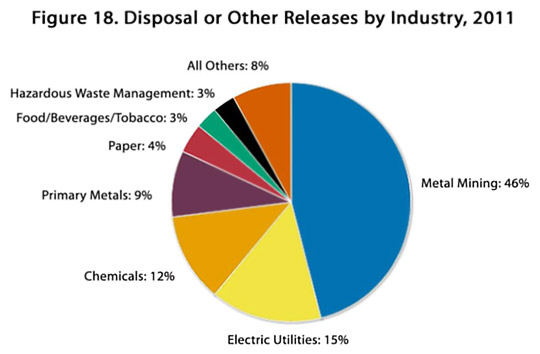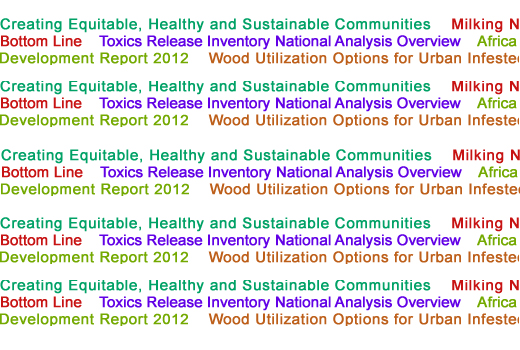New Sustainability Reports: Creating Equitable, Sustainable Communities
1. Creating Equitable, Healthy & Sustainable Communities
(www.epa.gov/environmentaljustice) – Communities across the country are integrating smart growth, environmental justice and equitable development approaches to design and build healthy, sustainable and inclusive neighborhoods. Overburdened communities are using smart growth strategies to address longstanding environmental and health challenges and to create new opportunities where they live. Regional and local planners are engaging low-income, minority and tribal residents in decision-making and producing more enduring development that is better for people and the environment. Community groups, government agencies and private and nonprofit partners are cleaning-up and investing in existing neighborhoods, providing affordable housing and transportation options, and improving access to critical services and amenities.
U.S. Environmental Protection Agency publication Creating Equitable, Healthy and Sustainable Communities: Strategies for Advancing Smart Growth, Environmental Justice and Equitable Development builds on past successes and offers other low-income, minority, tribal and overburdened communities approaches to shape development that responds to their needs and reflects their values. It identifies strategies that bring together smart growth, environmental justice and equitable development principles. Community-based organizations, local and regional decision-makers, developers and others can use this information to build healthy, sustainable and inclusive communities. Such places provide clean air, water and land; affordable and healthy homes; safe, reliable and economical transportation options; and convenient access to jobs, schools, parks, shopping and other daily necessities.
Strategies are grouped under seven common elements or shared goals and principles that connect environmental justice, smart growth and equitable development. The fundamental overlap between these concepts is around how to plan and build neighborhoods to address environmental, health and economic disparities and provide opportunities for low-income, minority, tribal and overburdened residents. Therefore, all approaches described relate to land use and community design. This document provides a brief introduction to each strategy with a description of what it is, how it supports equitable and environmentally sustainable development and examples of how it has been used. Local governments and community-based organizations can choose approaches that best suit their needs and goals. Each of the seven common elements is illustrated by an in-depth case study highlighting a community’s experiences with these strategies.
2. Milking Nature’s Bottom Line
(www.landenconsulting.com) – An “industrial mega-dairy” (named Tradition Investments, LLC or Tradition Family Dairy, LLC) is attempting to site itself in the rolling hills of Jo Daviess County, a picturesque region of northwest Illinois, U.S.A., with a unique geology, geography and ecology. The region retains a strong, small family farming, traditional rural identity. The project has been the subject of much controversy with numerous objections raised on ecological and socioeconomic grounds. Like many business and public-policy decisions not explicitly made with a sustainable “triple bottom line” focus, the community’s economic cost-benefit conversation has focused primarily on economic benefits the facility could bring to the region. However, Concentrated Animal Feeding Operations, or CAFOs, frequently arrive with significant ecological and social costs. This report, Milking Nature’s Bottom Line: A Full-Cost Accounting of Proposed CAFO Operations in Jo Daviess County, Illinois, is aimed at bringing balance to the local policymaking conversation by explicitly accounting for regional economic costs associated with CAFO-related ecological and social degradation.
By establishing an “ecosystem services risk model,” we estimated the risk of CAFO-related impacts to the ecosystem services being examined. We also projected the economic consequences that could be expected to affect the community, supporting businesses, and its workers. The analysis showed that the TID CAFO would have a significant impact, resulting in a net one-time loss of $2.30M and annual losses of $5.07M every year thereafter to the community.
In the past, economic progress was measured purely in production-driven measures, such as Gross Domestic Product (GDP). However, these measures do not account for costs (and benefits) of natural and social capital embodied in ecosystems and people that help generate the economic output being measured. Nor do measures like GDP account for degradation to natural and social capital, which if left unchecked could impact the ability of the economic system to continue producing. In particular, the value of externalities (impacts to other stakeholders beyond the immediate entity being measured) is often not accounted for in a project design or management decision or a go/no-go decision for a new development.
However, continuing developments in ecological and economic science are changing this situation. We can now more accurately assess the effects of the ecological damage that unsustainable development inflicts. Furthermore, on the economic accounting side, numerous private- and public-sector initiatives are underway, which are integrating a full cost accounting approach that incorporates economic, ecological and social factors into the decision-making process. This report brings this integrated perspective to the Tradition Investments CAFO and examines the potential economic costs associated with CAFO-related ecological and social degradation.
3. Toxics Release Inventory National Analysis Overview
(www.epa.gov) – Tens of thousands of chemicals are used by industries and businesses in the United States to make the products on which our society depends, such as pharmaceuticals, clothing and automobiles. Many of the chemicals needed to create these products are toxic; therefore, some releases of toxic chemicals into the environment are inevitable. It is your right to know what chemicals are being used in your community, how they are being disposed of, and whether their releases are increasing or decreasing over time. The Toxics Release Inventory (TRI) is a database that contains detailed information on disposal or other releases of more than 650 chemicals from thousands of U.S. facilities that report to TRI. These toxic chemicals can be harmful to humans, the environment or both.
These facilities are typically large and are involved in manufacturing, metal mining, electric power generation and hazardous waste treatment. Federal facilities are also required to report to TRI by Executive Order. The latest report, 2011 TRI National Analysis, is EPA’s annual interpretation of TRI data, and it provides the public with valuable information on how toxic chemicals were managed, where toxic chemicals ended up and how 2011 compares to previous years.

Credit: EPA
4. Africa Human Development Report 2012
(www.undp.org) – Hunger and starvation in sub-Saharan Africa have lasted too long. But Africans are not consigned to a lifetime of food insecurity. The knowledge, technology and resources for closing the food security deficit are available today, and breakthroughs will continue to emerge from research and development. But no one believes it is possible simply to distribute better seeds and more fertilizer to African farmers and then to walk away. Nor will economic growth alone solve the problem. The failures that add up to food insecurity are pervasive, from agricultural, health, education and nutrition policies to research, extension services, sanitation, local government, commerce and transport. An effective response to a challenge this broad cannot be narrowed to a single intervention, discipline or institutional mandate. It will take a coordinated response across sectors.
This Africa Human Development Report, the first, argues that sustainable increases in agricultural productivity protect food entitlements – the ability of people to access food. Furthering human development requires nutrition policies that unleash the potential of today’s and future generations. Also, communities must be resilient enough to absorb shocks and have the power to make decisions.
For too long the face of sub-Saharan Africa has been one of dehumanizing hunger. More than one in four Africans is undernourished, and food insecurity – the inability to consistently acquire enough calories and nutrients for a healthy and productive life – is pervasive. The spectre of famine, which has virtually disappeared elsewhere in the world, continues to haunt parts of sub-Saharan Africa. Famines grab headlines, but chronic food insecurity and malnutrition are more insidious, often silent, daily calamities for millions of Africans.
Yet sub-Saharan Africa has ample agricultural land, plenty of water and a generally favourable climate for growing food. And in the last 10 years many African countries posted world-beating economic growth rates and were among the fastest movers on the Human Development Index. With these endowments and important economic and social achievements, why is the region still food insecure? These two jarring paradoxes are the point of departure for this report.
5. Wood Utilization Options for Urban Infested Trees
(www.fs.fed.us) – The introduction and spread of non-native invasive species are causing significant ecological and economic damage to U.S. urban and rural forests. The National Invasive Species Management Plan (2008) defines invasive species as a “species that is non-native to the ecosystem under consideration and whose introduction causes or is likely to cause economic or environmental harm or harm to human health.” As a result of infestation from invasive species, particularly emerald ash borer (EAB) but also Asian longhorned beetle (ALB), gypsy moth and thousand canker disease, tremendous numbers of infested trees are being killed and removed each year for control and ultimate eradication of the pests (USDA APHIS 2006). Proper utilization and safe disposal of woody biomass from these trees present considerable challenges to many local communities and landowners.
Urban forestry professionals are increasingly faced with the task of selecting appropriate utilization options for the materials and locating the necessary technical information for making such decisions. Although many studies and wood utilization projects have been conducted for wood from trees attacked by invasive species, much of the basic information on wood materials, product options and corresponding manufacturing requirements is published in numerous technical reports prepared by universities and other research organizations. While there are a number of agency websites available, no single location provides comprehensive information on wood technology, markets and technical information for hardwoods affected by invasive species.
The University of Minnesota Duluth’s Natural Resources Research Institute and the U.S. Dept. of Agriculture (USDA) Forest Products Laboratory have developed this downloadable book, Wood Utilization Options for Urban Trees Infested by Invasive Species, as a primary reference on these topics. The target audiences are land management professionals, arborists, utilization specialists and other natural resource professionals at the forefront of dealing with invasive species and their devastating effect on forest resources. The primary sections of the book are:
- Overview of Invasive Species and Utilization Options for Hardwoods
- Basic Wood Properties of Hardwoods Affected by Invasive Species
- Market and Utilization Options for Ash Logs, Lumber and Other Products
- Heat Treatment of Wood for Invasive Forest Pests
While these chapters are available as a printed book, they are also available under the utilization options tab on the EAB website: www.emeraldashborer.info. This web portal is a collaborative effort of the USDA Forest Service, Michigan State University, Purdue University and Ohio State University to provide comprehensive, accurate and timely information on the emerald ash borer to the site’s visitors. The site was created with support from the USDA Forest Service and is administered through Michigan State University (USDA et al. 2012).





























